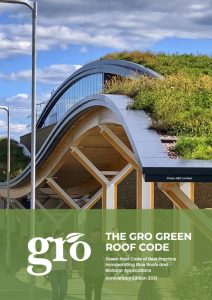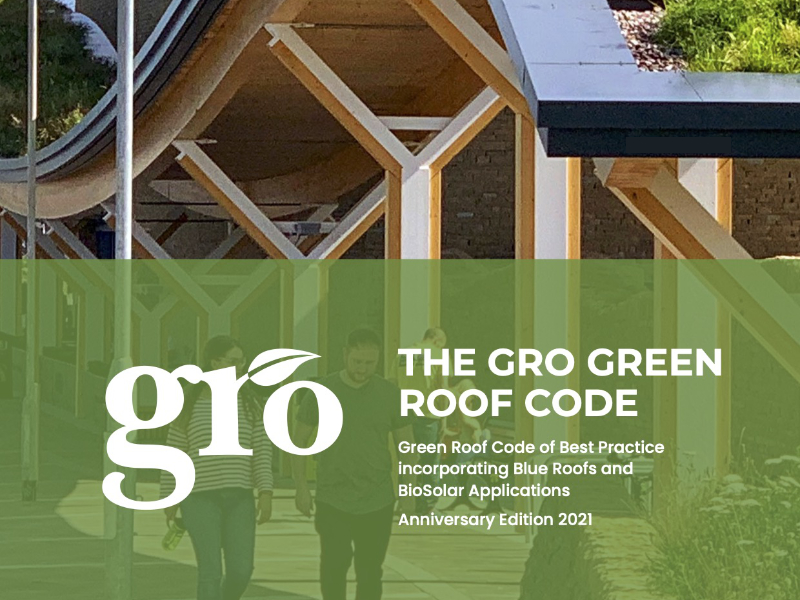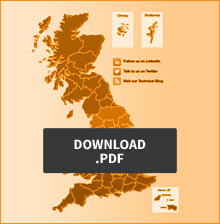The GRO Green Roof Code – a Green Roof Guide to Best Practice
Green roofs have become one of the ‘must haves’ amongst architects, homeowners, commercial developers and office owners seeking to enhance the environment or simply tick a sustainability box on a planning proposal. This is even more important with the statutory requirement for Biodiversity Net Gain (BNG) coming in this month for anything but small sites.
Whilst the market for green roofs has expanded at real pace in the past 20 years, and a specialist and dedicated group of experts has emerged, there is still much misinformation about the best way of choosing, installing and then maintaining an intensive, extensive or blue roof.
This is why GRO, the Green Roof Organisation, the trade association for the green roof industry in the UK developed a code of practice to clearly define what is required when planning, designing and creating a green roof. The guide, known as the GRO Green Roof Code, was originally published in 2011 and an updated, 10 year anniversary edition (known as the GRO Code of Best Practice) was published in 2021.
What does the GRO Green Roof Code Advise?
The guide covers the full process of choosing, designing, installing and maintaining a green roof, however the absolute critical element of the code is a minimum standard of a 60mm substrate on a sedum blanket. This is crucial to the sustainability of a green roof. Too many green roof projects fail because the depth of substrate is too shallow. The level of substrate allows planting to cope with the weather, especially in the summer where in a drought (even in the UK) where the roof will become stressed.
Failures of green roofs due to substrate depth are often caused by pressure on the specification. Often this is done as a result of ignorance and pursued because of the trend to lighter roofs. In almost all green roof specifications the structural integrity of the actual roof frame is not in question, but concerns around height and weight still lead to tweaks in the specification of substrates and consequently this affects the planting and long-term sustainability of the green roof itself. In London, where there are specific policies for green roofs, substrates are almost always around 80mm – but outside of London this is not always the case.
Designing your roof to the GRO green roof code guidelines and specifically requiring that the guide be adhered to, can help give weight to the case for better-designed green roofs and reduce the risk of a broken specification.
Definitive Best Practice in Green Roof Guidance
 The GRO code of practice is rooted in the German FLL Guideline for Green Roofs introduced in 1984 and first published in English in 2002. The FLL guideline is regarded as the definitive best practice guide for design, planning and installation of green roofs in the world.
The GRO code of practice is rooted in the German FLL Guideline for Green Roofs introduced in 1984 and first published in English in 2002. The FLL guideline is regarded as the definitive best practice guide for design, planning and installation of green roofs in the world.
The GRO code of practice offers a full explanation of how green roof contractors can work with architects, roof contractors and builders to establish a sustainable green roof. It clearly defines the benefits of deeper substrates and recommends contractual responsibilities in terms of planting and maintenance, helping ensure that a complex, living building system stands the best chance of preforming for decades to come.
The Green Roof Code 2021 is the first major update in the Code since 2014. It now includes definitions, specifications and guidelines on
- blue roofs, roofs that incorporate sustainable drainage systems (SuDS)
- biosolar roofs – green roof with solar panels
- biodiversity net gain (BNG).
The new GRO code drives best practice and is important for everyone up and down the roof supply chain to understand and to follow. Green roofs are not just a trend – they are good for the environment, attractive and here to stay. Applying the correct standards of practice will also make them sustainable.
Eco Green Roofs and the GRO Code
We asked Steven Vincent of Eco Green Roofs about the GRO Green Roof Code. He said,
“The GRO sets the bar for root-zone depth which is broadly based on the German FLL Green Roof Guide. You can grow grass at the edge of a muddy puddle, but it won’t last. It won’t be “sustainable”.
Different plants require different root-zone to flourish so this is why you might see a spec for 80mm to 150mm berms and mounds when it’s a biodiverse roof (which can be made up of sedum, grasses, wildflowers).
Sedum has been tested throughout the world in different climates and conditions, and they found that 80mm is the optimum i.e. if you use 30, 40 or 50mm, the sedum suffers over time. If you use 100mm, there is no extra benefit gained over 80mm, providing you use a free draining reservoir board like the EGR DBR20. If you use a “one-way” board (one that only drains or is only a reservoir) you are expected to increase the substrate zone sufficiently so as not to harm the plants (typically 40 to 50mm more).
Biodiverse roofs should be contoured to allow the deeper rooted species the chance to “take” and survive.”
More Information
- Download the GRO Green Roof Code of Best Practice from the GRO website
- We support the GRO Green Roof code, and our green roof suppliers Eco Green Roofs are GRO Members. Talk to us about your Green Roof Specification.














Recent Comments